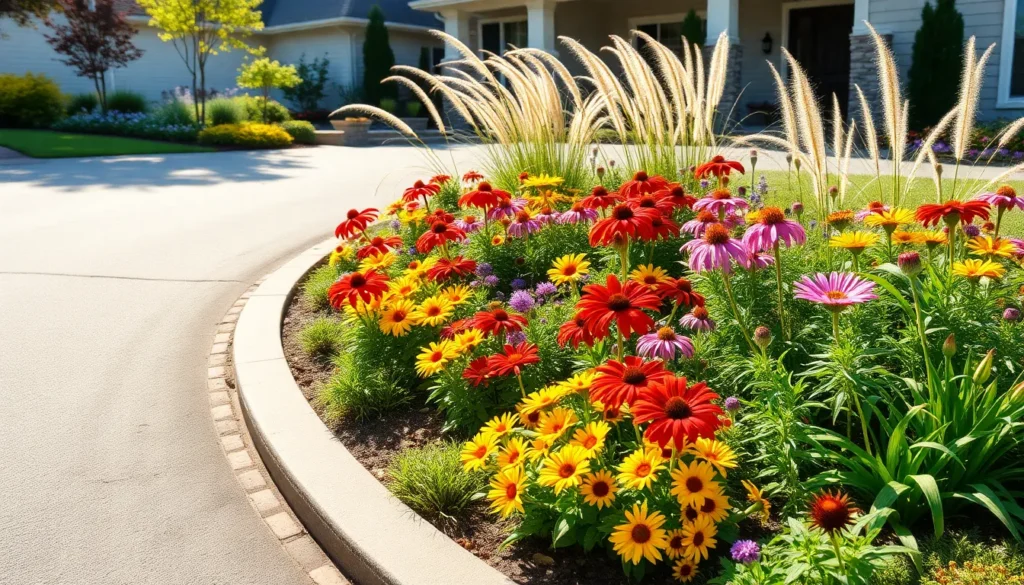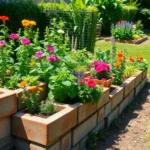We’ve all gazed at our plain concrete driveways and wondered how to transform these forgotten spaces into something beautiful. Your driveway doesn’t have to be just a parking spot – it’s prime real estate waiting to bloom with creative landscaping possibilities.
Driveway gardens offer the perfect solution for homeowners looking to maximize their outdoor space while boosting curb appeal. These strategic plantings can soften harsh concrete edges create welcoming entryways and even provide privacy screening from busy streets.
Whether you’re working with a long straight driveway or a curved entrance we’ll show you how to turn this overlooked area into a stunning garden feature. From low-maintenance succulents to colorful flower borders there’s a driveway garden style that’ll complement your home’s architecture and fit your lifestyle perfectly.
Transform Your Driveway Edges With Colorful Perennial Borders
Perennial borders offer the perfect solution for creating lasting beauty along driveway edges without the yearly replanting hassle. These permanent plantings establish strong root systems that return year after year, making them ideal investments for busy homeowners.
Choose Low-Maintenance Flowering Plants
Low-maintenance perennials thrive in driveway conditions while delivering consistent color throughout growing seasons. Daylilies adapt to various soil conditions and bloom repeatedly from early summer through fall, requiring minimal water once established. Black-eyed Susans tolerate drought and poor soil while producing bright yellow flowers that attract beneficial pollinators to your driveway garden.
Coneflowers resist deer and provide purple, pink, or white blooms that last from midsummer into autumn. We recommend planting them 18-24 inches apart for optimal air circulation and growth. Catmint creates fragrant borders with lavender-blue flowers and silvery foliage that stays attractive even when not blooming.
Sedum varieties offer succulent texture and late-season color, with ‘Autumn Joy’ producing pink flowers that transition to rust-colored seed heads. These plants require virtually no maintenance once established and can handle reflected heat from nearby pavement.
Create Seasonal Interest With Varied Bloom Times
Staggered bloom times ensure your driveway borders maintain color from spring through fall. Early spring bloomers like bergenia and hellebores emerge before most other plants, providing welcome color after winter dormancy. Late spring options including peonies and irises bridge the gap between early bloomers and summer favorites.
Summer flowering perennials carry the show during peak growing season, with rudbeckia, echinacea, and phlox providing continuous blooms. Fall bloomers like asters and chrysanthemums extend the display into autumn when many gardens begin to fade.
Planning your border with overlapping bloom periods creates what garden designers call “succession planting.” We suggest choosing at least one plant from each season to maintain consistent visual interest. Spring bulbs planted among perennials add extra early color before perennial foliage fills in completely.
Add Texture With Ornamental Grasses
Ornamental grasses provide structural backbone and movement to perennial borders while requiring minimal maintenance. Fountain grass creates soft, arching mounds with feathery plumes that catch morning light beautifully. Blue fescue forms compact clumps of steel-blue foliage that contrasts nicely with colorful flowering perennials.
Maiden grass reaches 4-6 feet tall and works well as a backdrop for shorter perennials in wide driveway borders. Feather reed grass grows upright and narrow, making it perfect for tight spaces between driveways and walkways.
These grasses add winter interest when their dried seed heads and foliage remain attractive through cold months. Switchgrass provides golden fall color and sturdy vertical structure that complements horizontal driveway lines. Plant grasses in odd-numbered groups of three or five for the most natural appearance in your driveway garden design.
Design Stunning Container Gardens Along Your Driveway
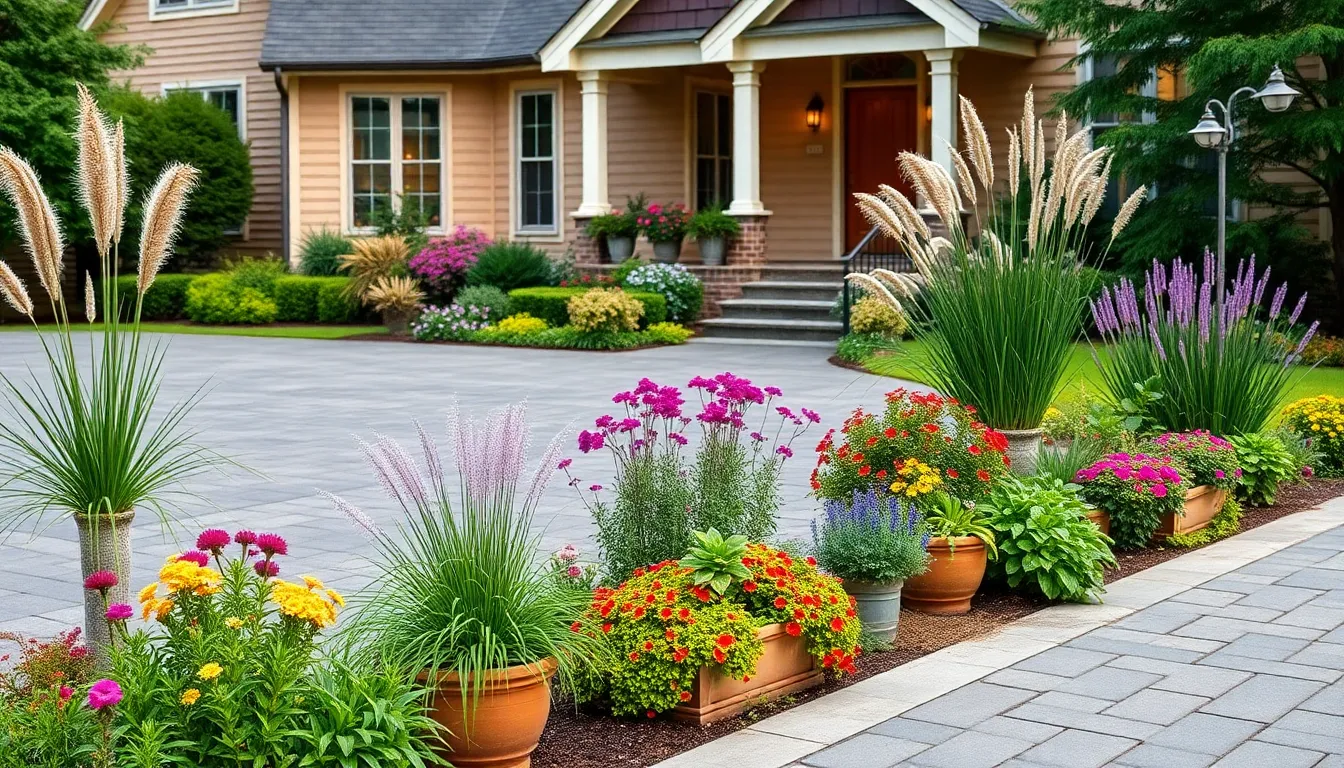
Container gardens offer endless possibilities for creating beautiful displays that complement your home’s entrance while providing flexibility in plant selection and arrangement.
Select Weather-Resistant Planters and Pots
Choosing the right containers sets the foundation for successful driveway gardens. Weather-resistant planters made from materials like fiberglass, ceramic, or composite materials withstand temperature fluctuations and moisture better than traditional clay pots. Large containers retain moisture longer and provide better root protection during extreme weather conditions.
Position containers strategically along your driveway’s edge or near your entrance. Group planters in odd numbers like three or five to create visual balance and natural appeal. Heavy containers work best for driveway locations since they won’t tip over during windy conditions or when bumped by car doors.
Select containers with proper drainage holes to prevent waterlogging. Well-draining pots keep plant roots healthy and prevent soil from becoming waterlogged during heavy rainfall. Consider containers with built-in water reservoirs for plants that require consistent moisture levels.
Layer Plants for Maximum Visual Impact
Layered planting creates depth and visual interest in your container displays. Place taller plants like ornamental grasses or small shrubs in the back of containers, with medium-height flowering plants in the middle section. Trailing plants and low-growing varieties fill the front edges and spill over container rims.
Combine different plant heights to achieve maximum visual impact throughout the growing season. Tall specimens like fountain grass or small evergreen shrubs provide structure and backdrop. Medium plants such as colorful annuals or perennials create the main focal point with their blooms and foliage.
Mix textures and leaf shapes to add complexity to your arrangements. Broad-leafed plants like hostas contrast beautifully with spiky ornamental grasses or needle-like evergreen foliage. Smooth-leafed plants paired with fuzzy or serrated varieties create captivating tactile and visual contrasts.
Incorporate Year-Round Greenery
Evergreen shrubs provide consistent structure and color throughout all seasons. Small conifers like dwarf Alberta spruce, compact junipers, or miniature pine varieties maintain their appearance during winter months when other plants go dormant. These plants anchor your container displays and provide reliable green color year-round.
Add seasonal interest with plants that offer winter appeal beyond just green foliage. Ornamental grasses with attractive seed heads, berry-producing shrubs, or plants with colorful bark provide visual interest during dormant months. These elements ensure your driveway containers remain attractive even when flowering plants aren’t blooming.
Rotate seasonal annuals around your permanent evergreen plantings. Spring bulbs, summer flowering annuals, and fall chrysanthemums can be swapped out seasonally while maintaining the consistent backbone of evergreen plants. This approach keeps your containers looking fresh and seasonally appropriate while minimizing replanting efforts.
Install Raised Garden Beds for Enhanced Curb Appeal
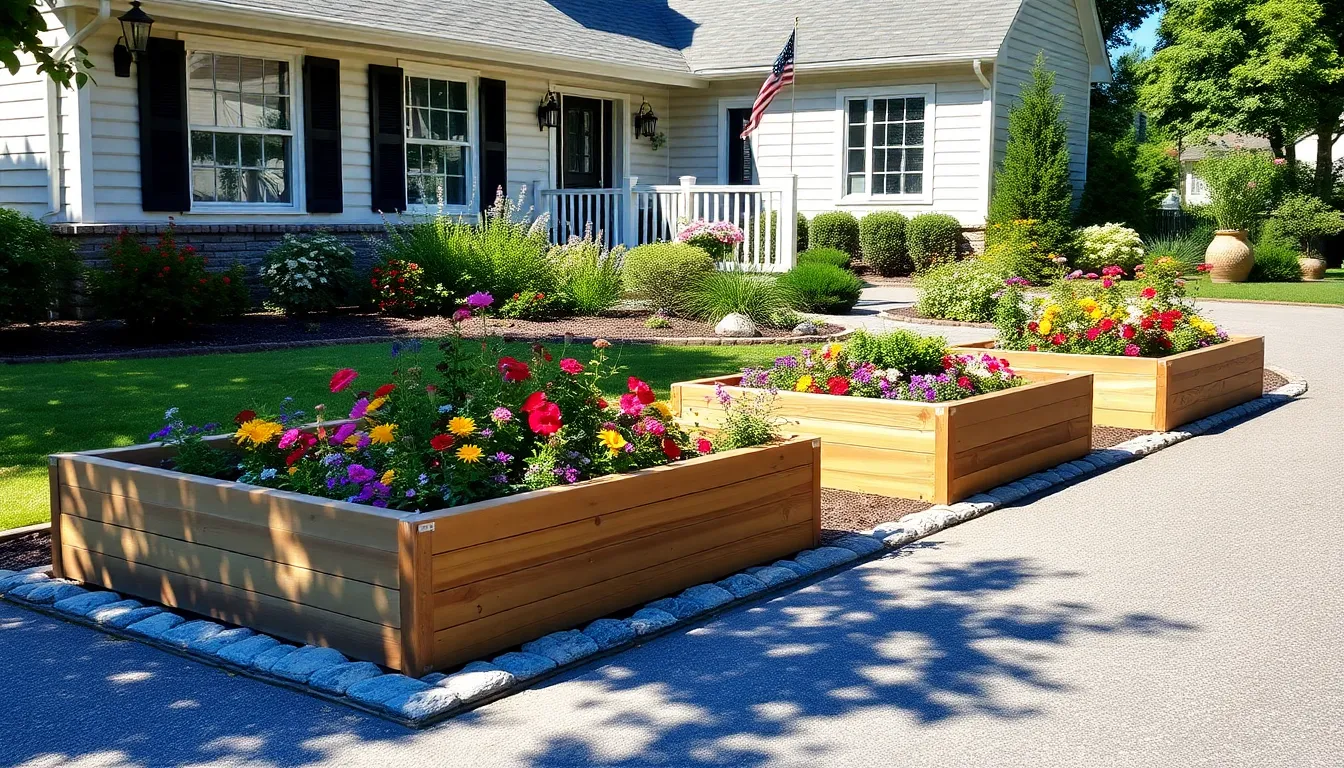
Raised garden beds transform ordinary driveways into stunning industry features that catch the eye from the street. We’ll create elevated planting spaces that showcase your favorite flowers and plants while adding structural interest to your property’s entrance.
Build Custom Wooden or Stone Planters
Custom planters offer unlimited design possibilities for your driveway garden transformation. We recommend constructing wooden planters using cedar or redwood for natural weather resistance, while stone options like granite or limestone provide lasting durability. These elevated structures can accommodate a diverse mix of flowers, shrubs, or small ornamental trees that create visual depth along your driveway edges.
Strategic placement of these custom planters maximizes their impact on your home’s curb appeal. We suggest positioning larger planters at entrance points and using smaller versions to create rhythm along longer driveways. Installing a drip irrigation system within these planters ensures efficient watering while reducing maintenance time, making it easier to keep your plants thriving throughout the growing season.
Choose Appropriate Soil Depth for Plant Types
Soil depth requirements vary significantly depending on your chosen plant varieties and their root systems. We need to provide 6 to 8 inches of soil for shallow rooted annuals like petunias and marigolds, while perennials such as daylilies require 12 to 18 inches for proper root development. Deep rooted shrubs and small trees need 24 to 36 inches of quality soil to establish strong foundation systems.
Matching soil depth to plant requirements prevents root bound conditions and promotes healthy growth patterns. We recommend creating a planting plan that groups plants with similar soil depth needs together, making it easier to construct appropriately sized raised beds. Quality potting mix combined with compost provides the drainage and nutrients necessary for optimal plant performance in these elevated growing spaces.
Create Defined Lines and Clean Edges
Defined borders between your raised garden beds and driveway surfaces create professional looking industry installations. We achieve crisp edges using decorative materials like flagstone, brick pavers, or natural stone that complement your home’s architectural style. These edging materials prevent soil spillage onto driveways while creating clear boundaries that enhance the overall design aesthetic.
Geometric precision in your edging installation elevates the entire driveway garden from amateur to professional quality. We recommend using string lines and stakes to ensure straight edges, while curved sections benefit from flexible edging materials that follow natural contours. Regular maintenance of these defined borders keeps grass and weeds from encroaching into your planted areas, preserving the clean appearance that makes raised garden beds so visually appealing.
Create Beautiful Rock Gardens and Xeriscapes

Rock gardens and xeriscapes offer stunning, low maintenance alternatives to traditional lawns that perfectly complement driveway areas. These water efficient landscapes combine natural stone elements with hardy plants to create visually striking displays.
Design With Native Drought-Tolerant Plants
Native drought tolerant plants form the foundation of successful driveway rock gardens and xeriscapes. Black-Eyed Susans bring vibrant yellow blooms to your industry while requiring minimal water once established. Butterfly Weed adds brilliant orange flowers that attract pollinators and thrive in dry conditions.
Hardy native plants adapt naturally to your local climate conditions, reducing the need for frequent watering and fertilization. Succulents and cacti work exceptionally well in xeriscapes, providing unique textures and forms that create visual interest year round. We recommend selecting plants that naturally occur in your region, as they’ll establish quickly and require less ongoing care.
Drought tolerant varieties survive extended dry periods, making them ideal for areas with water restrictions or naturally low rainfall. Combining different heights and textures creates depth in your plantings while maintaining the water wise approach that makes these gardens so practical.
Incorporate Decorative Stones and Mulch
Decorative stones serve multiple functional and aesthetic purposes in driveway rock gardens. Gravel and pebbles add textural contrast while improving drainage around plant roots, preventing water logged soil conditions that can damage drought tolerant species.
Stone materials create natural looking pathways and define planted areas within your garden design. River rocks, decomposed granite, and colored gravels provide different visual effects while suppressing weed growth naturally.
Organic mulch complements stone elements by retaining soil moisture and maintaining consistent soil temperatures. We suggest applying a thin layer of bark chips or wood mulch around larger plants, then transitioning to decorative stones in open areas for a cohesive look.
Mulch application helps suppress weeds while maintaining the neat, organized appearance that makes driveway gardens so appealing. The combination of stones and organic materials creates visual layers that enhance the natural beauty of your xeriscaped areas.
Add Architectural Elements Like Boulders
Boulders create dramatic focal points that anchor your driveway rock garden design with natural sculptural elements. Large stones add vertical interest and depth, breaking up flat expanses while providing structural framework for your plantings.
Strategic boulder placement defines garden borders and creates natural looking retaining walls that prevent soil erosion. We recommend positioning these substantial stones first, then designing plant arrangements around them for the most natural appearance.
Structural stone elements like boulders work as backdrops for smaller plants, highlighting their forms and colors against neutral stone surfaces. Natural weathering patterns on boulder surfaces add authentic character that manufactured materials can’t replicate.
Decorative stone borders created with smaller rocks can connect larger boulder features throughout your garden space. This creates visual continuity while maintaining the low maintenance benefits that make rock gardens perfect for busy driveway areas.
Plant Vertical Gardens on Retaining Walls

Vertical gardens transform ordinary retaining walls into stunning green features that maximize our driveway’s visual impact. These space-saving answers increase aesthetic appeal while reducing harsh wall visibility and adding valuable biodiversity to our outdoor spaces.
Install Wall-Mounted Planter Systems
Wall-mounted planter systems offer the perfect solution for adding greenery without sacrificing valuable ground space along our driveways. We can easily install these versatile systems on most wall types, creating customizable plant arrangements that suit our exact design preferences. Modern wall-mounted planters come in materials like powder-coated steel, cedar wood, and recycled plastic that withstand harsh weather conditions.
Strategic placement allows us to create stunning vertical displays at eye level where guests can fully appreciate the plantings. Multiple tiers work exceptionally well for showcasing different plant varieties while maintaining easy access for watering and maintenance. We should position these systems where they’ll receive appropriate sunlight for our chosen plants while avoiding areas that might interfere with vehicle access.
Choose Cascading and Climbing Varieties
Cascading and climbing plants create dramatic visual interest by adding depth and texture to our vertical garden displays. English ivy provides year-round coverage with its glossy evergreen leaves that cascade beautifully over wall edges. Clematis offers spectacular seasonal blooms in purple, white, and pink varieties that climb naturally up trellises or wall-mounted supports.
Wisteria creates breathtaking spring displays with its fragrant purple or white flower clusters that drape elegantly from elevated planters. These climbing varieties require sturdy support structures but reward us with ever-changing displays that change throughout the growing seasons. We can combine different cascading plants to ensure continuous visual appeal from spring through fall.
Create Living Privacy Screens
Living privacy screens using evergreen shrubs and ornamental grasses provide natural barriers while maintaining year-round structure and color. Black mondo grass creates elegant dark foliage that contrasts beautifully with lighter colored driveways and walls. Corkscrew grass adds unique twisted texture that moves gracefully in breezes while providing dense coverage.
Blue oat grass offers striking blue-green color that maintains its appearance through multiple seasons, creating sophisticated layered looks when combined with other varieties. These hardy plants establish natural boundaries between our driveway space and neighboring properties without requiring the maintenance of traditional fencing. We can arrange different grass heights to create graduated privacy levels that look professionally landscaped while serving practical purposes.
Establish Functional Herb and Vegetable Gardens
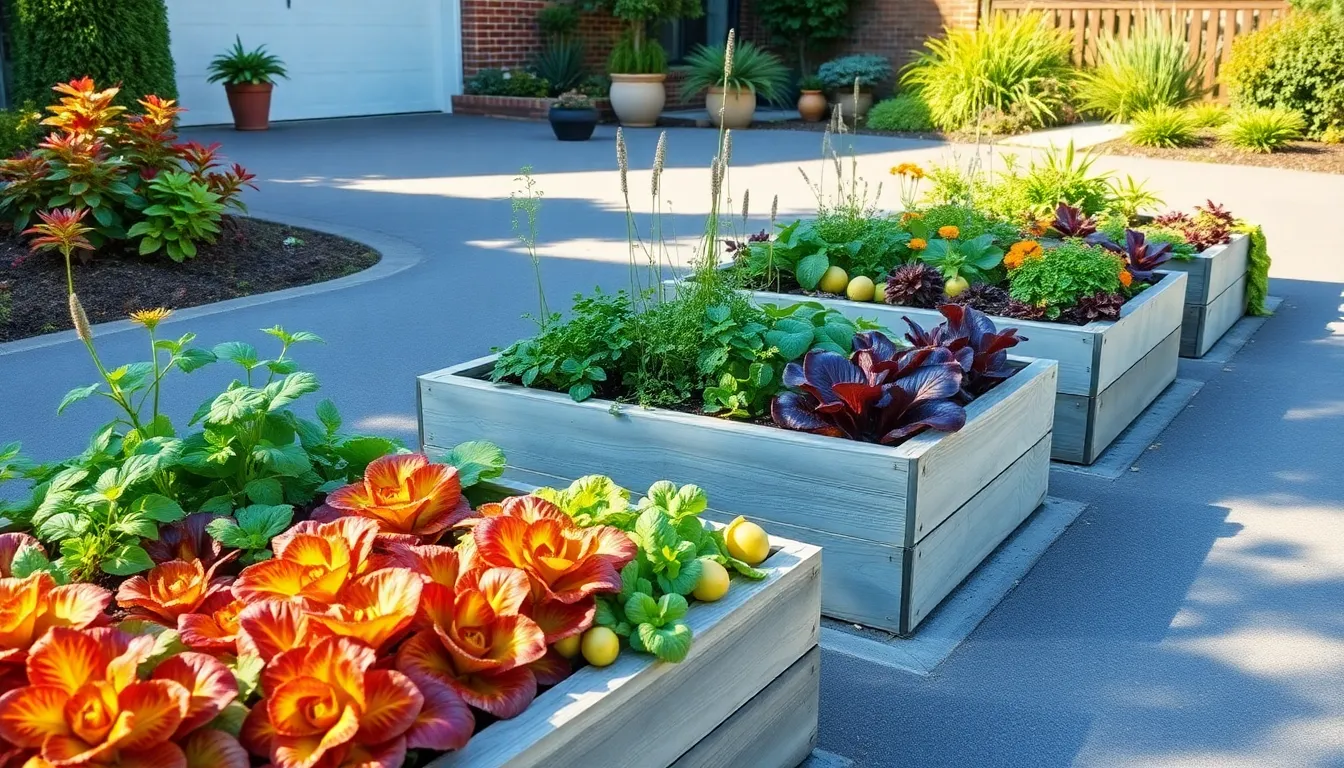
Transforming your driveway garden into a productive growing space combines beauty with practicality. We’ll show you how to create thriving herb and vegetable gardens that enhance your driveway’s appeal while providing fresh ingredients for your kitchen.
Position for Optimal Sun Exposure
Assessing the sun patterns in your driveway area forms the foundation of successful herb and vegetable gardening. Most vegetables and herbs require at least 6 hours of direct sunlight daily to produce abundant harvests. We recommend observing your driveway space throughout the day to identify the sunniest locations for your most sun-loving plants.
Creating raised beds with trellises maximizes sunlight capture when your driveway doesn’t receive direct sunlight all day. Elevated growing spaces allow us to position plants at optimal heights for light exposure while improving drainage and soil conditions. Strategic placement of these beds ensures your herbs and vegetables receive the maximum amount of available sunlight.
Select Compact Varieties for Small Spaces
Choosing compact vegetable varieties designed specifically for small spaces ensures productive harvests in limited driveway garden areas. ‘Patio’ tomatoes, ‘Space’ spinach, and ‘Thumbelina’ carrots thrive in confined growing spaces while delivering full-sized flavors. These specialized varieties produce impressive yields without requiring extensive garden real estate.
Selecting compact herbs like basil ‘Genovese’, mint, and thyme provides fresh culinary ingredients while maintaining manageable plant sizes. These herbs grow easily in small beds and containers, making them perfect choices for driveway gardens where space comes at a premium. Regular harvesting keeps these herbs bushy and productive throughout the growing season.
Include Attractive Edible Landscaping Options
Using edible plants as decorative edging creates functional beauty that serves dual purposes in your driveway garden. Lettuce varieties and low-growing herbs form attractive borders while providing fresh ingredients for your meals. This approach maximizes the productive potential of every square inch in your driveway growing space.
Incorporating planters filled with colorful vegetables and herbs beautifies your driveway area while maintaining easy access for harvesting. Mixed plantings of purple kale, red lettuce, and green herbs create stunning visual displays that rival traditional ornamental plants. These attractive arrangements prove that functional gardens can be just as beautiful as purely decorative landscapes.
Incorporate Water Features and Garden Accents

Elevating your driveway garden beyond plants and hardscaping creates a truly memorable outdoor space. These finishing touches transform ordinary driveways into stunning industry features that welcome guests and enhance your home’s curb appeal.
Add Small Fountains or Birdbaths
Small fountains serve as elegant centerpieces that add sophistication to any driveway garden design. We recommend positioning compact fountains near entryways where their soothing sounds create a welcoming atmosphere for visitors. Tabletop fountains work perfectly in smaller spaces while freestanding models make bold statements in larger driveway areas.
Birdbaths attract wildlife and create lively focal points that bring movement to your garden space. Installing birdbaths in visible locations allows you to enjoy watching birds while providing them with essential water sources. We suggest choosing weather-resistant materials like stone or ceramic that complement your existing industry elements.
Consider the maintenance requirements when selecting water features for your driveway garden. Solar-powered fountains eliminate the need for electrical connections while self-circulating designs minimize water waste and upkeep.
Install Solar-Powered Lighting Elements
Solar-powered lights illuminate pathways without increasing electricity costs or requiring complex wiring installations. We recommend spacing pathway lights every 6-8 feet along walkways to create consistent illumination that guides visitors safely to your entrance. Stake lights work well for highlighting exact plants or garden features throughout your driveway industry.
Spotlights powered by solar energy can dramatically showcase your favorite trees, sculptures, or architectural elements after dark. Position uplights at the base of specimen plants to create stunning shadow patterns on nearby walls or surfaces. We’ve found that LED solar fixtures provide the brightest output while lasting longer than traditional bulb alternatives.
String lights add festive ambiance to pergolas, arbors, or fence lines within your driveway garden space. Solar string lights eliminate the hassle of extension cords while creating magical evening atmospheres for outdoor entertaining.
Place Decorative Garden Art and Sculptures
Decorative garden art adds personality and reflects your unique style preferences throughout the driveway industry. We suggest selecting pieces that complement your home’s architectural style, whether you prefer modern abstract sculptures or traditional nature-inspired designs. Metal sculptures withstand weather extremes while ceramic pieces offer colorful artistic expressions.
Strategically placing garden art creates visual interest and draws attention to exact areas within your driveway garden. Position larger sculptures as focal points at garden entrances or pathway intersections where they’ll have maximum impact. Smaller decorative elements work beautifully nestled among plantings or displayed on pedestals throughout the space.
Consider seasonal rotation of decorative pieces to keep your driveway garden fresh and captivating year-round. Weather-resistant materials like powder-coated metal, natural stone, or treated wood ensure your artistic investments maintain their beauty through changing seasons and environmental conditions.
Design Low-Maintenance Ground Cover Solutions
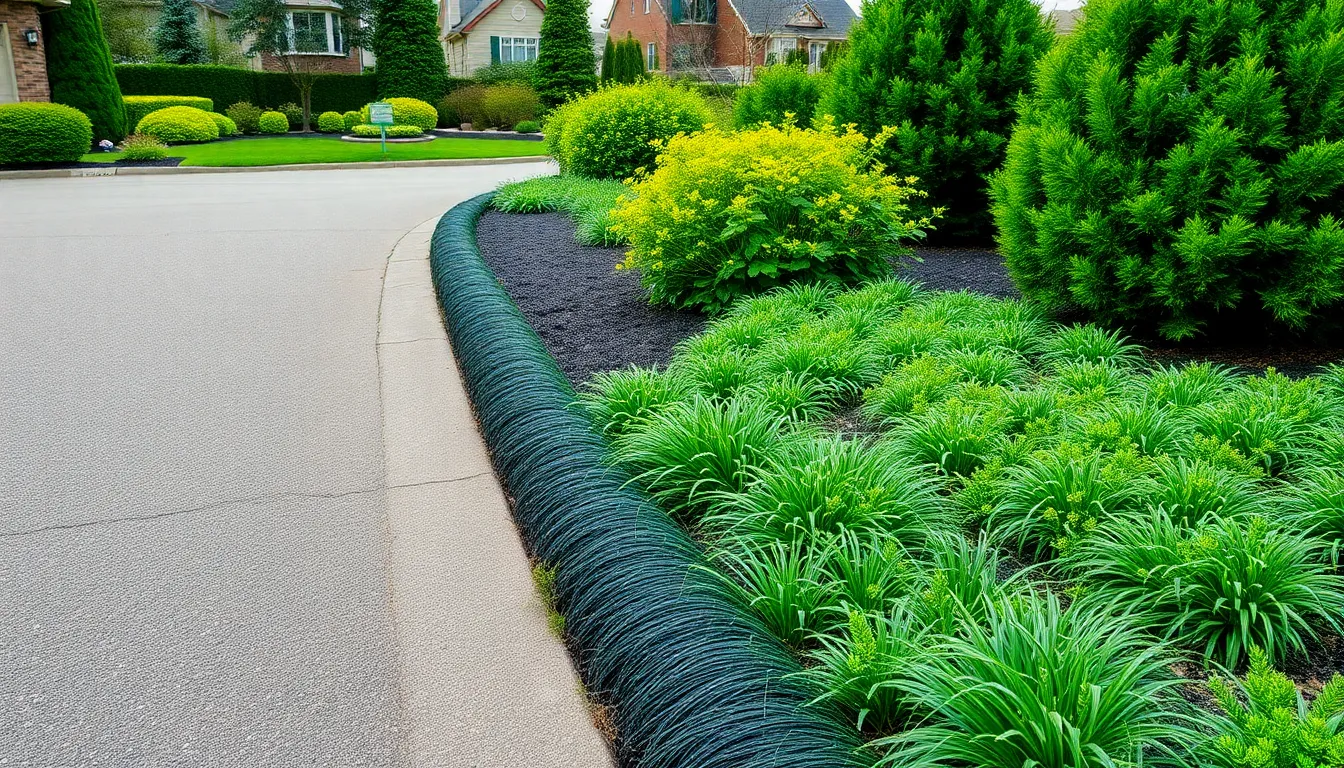
Ground cover answers transform bare driveway edges into lush, sustainable landscapes that require minimal upkeep. Smart plant selection eliminates the need for constant watering, weeding, and replanting while creating beautiful year-round appeal.
Replace Grass With Hardy Alternatives
Native plants offer the most resilient solution for driveway ground cover since they’re naturally adapted to local climate conditions. Black-Eyed Susans, Butterfly Weed, and Prairie Dropseed thrive in challenging driveway environments like those found in Cincinnati and similar regions. These plants establish deep root systems that help them survive drought conditions and temperature fluctuations.
Ornamental grasses create stunning texture and movement while requiring virtually no maintenance once established. Black mondo grass provides deep, dramatic color in front plantings, while corkscrew grass adds unique architectural interest. Blue oat grass works perfectly as a backdrop when you plant shorter varieties in front and taller ones behind for a layered effect.
Evergreen shrubs deliver consistent beauty throughout all seasons without the seasonal die-back that traditional grass experiences. These hardy alternatives establish permanent root systems that prevent soil erosion along driveway edges while providing structure and year-round greenery.
Use Spreading Plants to Prevent Weeds
Creeping thyme and creeping juniper spread rapidly across open ground to create dense mats that naturally suppress weed growth. These aggressive spreaders fill gaps between pavers and along driveway borders, eliminating spaces where unwanted plants typically establish themselves. Their low-growing nature means they won’t obstruct sightlines or create maintenance headaches.
Dwarf mondo grass functions as an excellent spreading ground cover that forms thick colonies over time. This grass variety stays consistently low and dense, creating an impenetrable barrier that prevents weed seeds from germinating. Its spreading habit means you can plant fewer initial specimens and watch them naturally fill the space.
Strategic placement of spreading plants creates natural weed barriers without requiring chemical treatments or constant manual removal. Dense ground cover eliminates the light and space that weeds need to establish, providing long-term weed prevention through natural competition.
Choose Evergreen Options for Year-Round Coverage
Evergreen yew shrubs paired with flowering plants like lavender create straight hedge lines that maintain their appearance through winter months. These shrubs provide consistent green backdrop that highlights seasonal blooms while ensuring your driveway garden never looks bare or dormant.
Boxwood remains the gold standard for evergreen ground coverage due to its dense foliage and adaptability to various growing conditions. This popular shrub works equally well for low hedges and topiary features, maintaining its shape and color regardless of season. Its compact growth habit makes it perfect for driveway applications where space is limited.
Evergreen selections ensure your driveway garden maintains visual interest during dormant seasons when deciduous plants lose their leaves. Year-round coverage provides consistent curb appeal and prevents bare soil from becoming muddy or eroded during winter weather.
Plan for Seasonal Color and Interest
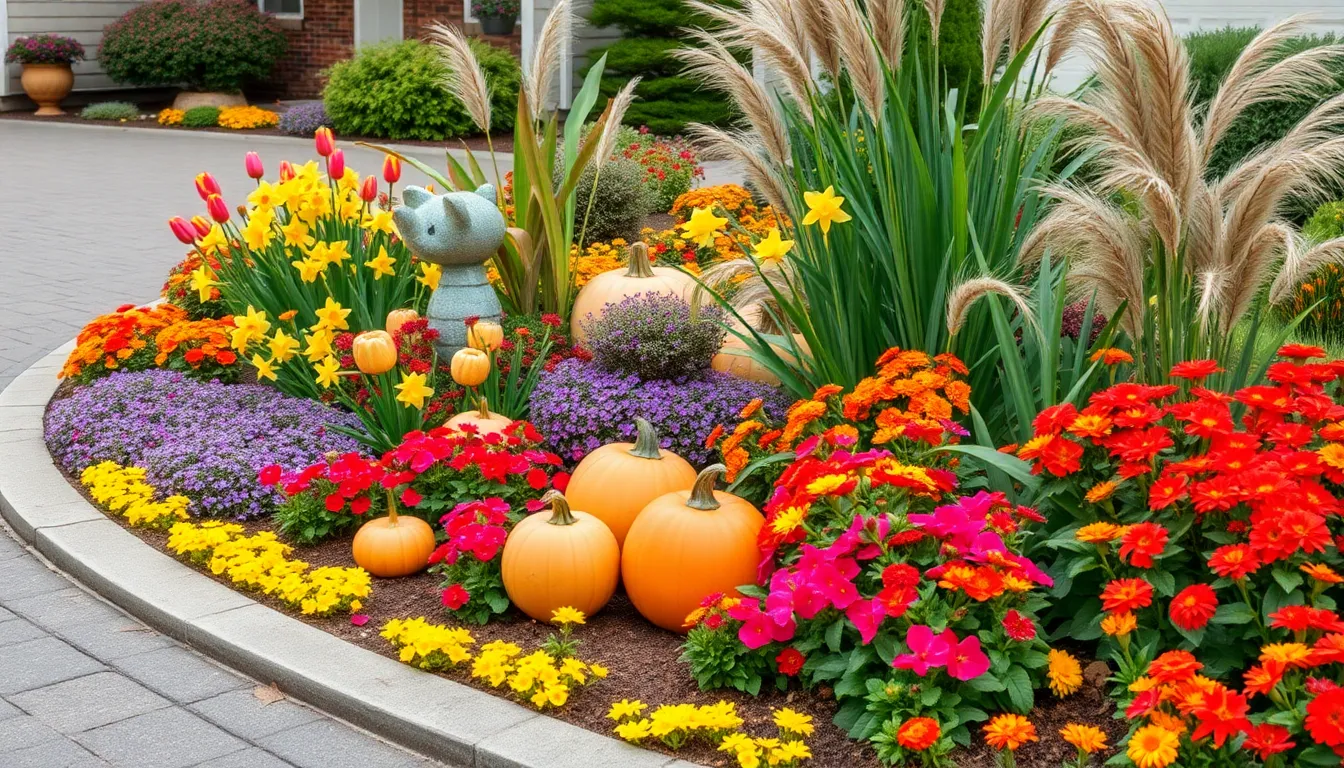
Building on our foundation of perennial borders and container gardens, we need to strategically plan plantings that deliver vibrant displays throughout the entire growing season. Creating year round visual impact requires thoughtful selection of plants that bloom at different times and offer varying textures and colors.
Rotate Annuals for Continuous Blooms
Rotating annuals throughout the growing season ensures our driveway gardens maintain consistent color and visual appeal. We recommend planting cool season varieties like pansies and snapdragons during spring and fall months when temperatures remain moderate. These hardy flowers thrive in cooler weather and provide brilliant colors when many perennials are dormant.
Summer brings opportunities to showcase warm season annuals such as petunias, marigolds, and impatiens that flourish in higher temperatures. Switching out spent cool season plants with heat loving varieties keeps our displays fresh and vibrant during the hottest months. Strategic timing of these rotations typically occurs in late spring and early fall to maximize each plant’s peak performance period.
Container gardens make annual rotation particularly simple since we can easily swap out entire pots rather than replanting individual sections. This flexibility allows us to experiment with different color combinations and plant varieties each season while maintaining our overall design aesthetic.
Include Spring Bulbs for Early Color
Spring bulbs provide essential early season color when most other plants remain dormant from winter. We plant tulips, daffodils, and hyacinths in fall before ground freezing occurs to ensure spectacular blooms emerge as soon as spring weather arrives. These early bloomers create immediate visual impact and signal the beginning of our garden’s seasonal transformation.
Layering different bulb varieties extends the spring blooming period from early March through late May in most regions. Early bloomers like crocuses and snowdrops appear first, followed by daffodils and tulips, then finishing with late season varieties like alliums and Dutch iris. This succession planting strategy maintains continuous spring color for several months.
Naturalizing bulbs in driveway garden areas creates low maintenance displays that return stronger each year. We recommend planting bulbs in clusters or drifts rather than straight lines to achieve more natural looking results that complement our existing industry design.
Add Fall-Interest Plants and Decorative Elements
Fall interest plants extend our garden’s appeal well into autumn when many summer bloomers begin to fade. Asters and sedum varieties mentioned in our planning provide excellent late season color and attract beneficial pollinators during their final foraging period. These hardy perennials offer rich purples, pinks, and yellows that complement autumn’s natural color palette.
Ornamental grasses reach their peak beauty during fall months, displaying feathery plumes and golden foliage that adds texture and movement to our driveway gardens. Fountain grass and maiden grass create dramatic backdrops while blue fescue provides subtle accent colors that enhance other fall flowering plants.
Incorporating seasonal decorative elements like pumpkins, gourds, and autumn themed containers adds festive appeal without requiring permanent installations. We can easily update these displays throughout fall by swapping decorations and adding seasonal plants like chrysanthemums and ornamental kale for additional color and interest.
Weather resistant planters allow us to create portable fall displays that can be repositioned as needed while protecting more tender plants from harsh weather conditions. These flexible arrangements let us maintain beautiful driveway gardens even as temperatures drop and growing conditions become more challenging.
Conclusion
We’ve explored many ways to transform your driveway from a simple concrete path into a stunning garden showcase. From low-maintenance perennial borders to dramatic vertical gardens and functional herb plots these ideas prove that every driveway has untapped potential.
The key to success lies in choosing plants and features that match your climate lifestyle and maintenance preferences. Whether you prefer the simplicity of ornamental grasses or the complexity of seasonal container displays there’s a solution that’ll work for your space.
Remember that small changes can make a big impact. Start with one area and gradually expand your driveway garden as you gain confidence and experience. Your neighbors will surely notice the transformation and you’ll enjoy the enhanced curb appeal for years to come.
Frequently Asked Questions
What are the main benefits of creating a driveway garden?
Driveway gardens enhance curb appeal by softening harsh concrete edges and creating welcoming entryways. They provide natural privacy from busy streets while adding color and visual interest to your property. These gardens can also increase home value and create beautiful outdoor spaces that complement your home’s architecture.
Which plants work best for driveway garden borders?
Perennial flowers like daylilies, black-eyed Susans, coneflowers, and catmint are ideal for driveway borders. These plants thrive in challenging conditions, require minimal maintenance, and return year after year. Choose varieties with staggered bloom times to ensure continuous color throughout the growing season.
How do ornamental grasses benefit driveway gardens?
Ornamental grasses like fountain grass, blue fescue, and maiden grass add texture and movement to driveway gardens. They provide visual interest during the growing season and maintain their structure through winter, offering year-round appeal. These grasses are also drought-tolerant and require minimal maintenance once established.
What should I consider when using containers for driveway gardens?
Select weather-resistant planters with proper drainage holes to prevent waterlogged roots. Position containers strategically for maximum visual impact and ensure they receive appropriate sunlight for your chosen plants. Layer plants of different heights and textures within containers to create depth and visual interest.
How do raised garden beds enhance driveway appeal?
Raised beds create elevated planting spaces that showcase flowers and plants more prominently. They offer better soil control, improved drainage, and easier maintenance. Custom wooden or stone planters add structural interest while providing appropriate soil depth for different plant root systems.
What makes rock gardens suitable for driveway areas?
Rock gardens require minimal maintenance and thrive in challenging driveway conditions. They use drought-tolerant native plants like black-eyed Susans and butterfly weed that need little water. Decorative stones and mulch improve drainage, suppress weeds, and create visually appealing, professional-looking installations.
How can vertical gardens transform driveway retaining walls?
Wall-mounted planter systems maximize green space without sacrificing ground area. Cascading plants like English ivy create dramatic visual interest, while climbing varieties can form living privacy screens. Choose weather-resistant materials and consider evergreen shrubs for year-round coverage and natural barriers.
Can I grow herbs and vegetables in my driveway garden?
Yes! Herb and vegetable gardens combine beauty with functionality. Assess sun exposure, create raised beds with trellises for optimal light, and select compact varieties suitable for small spaces. Use edible plants as decorative edging and incorporate colorful vegetables in planters for stunning, practical displays.
What water features work well in driveway gardens?
Small fountains and birdbaths create attractive focal points while attracting beneficial wildlife. Solar-powered features are eco-friendly and eliminate electrical installation needs. Consider the scale of your space and choose features that complement rather than overwhelm your garden design.
Which ground cover plants require the least maintenance?
Native spreading plants like creeping thyme and dwarf mondo grass create dense mats that naturally suppress weeds. Ornamental grasses provide texture with minimal care, while evergreen shrubs offer year-round coverage. These plants adapt well to driveway conditions and require little ongoing maintenance.
How can I ensure year-round color in my driveway garden?
Plant spring bulbs for early color, rotate cool-season annuals in spring and fall, and use warm-season varieties in summer. Incorporate fall-blooming plants like asters and sedum, and add seasonal decorative elements like pumpkins. Layer different bulb varieties for extended blooming periods throughout the seasons.

